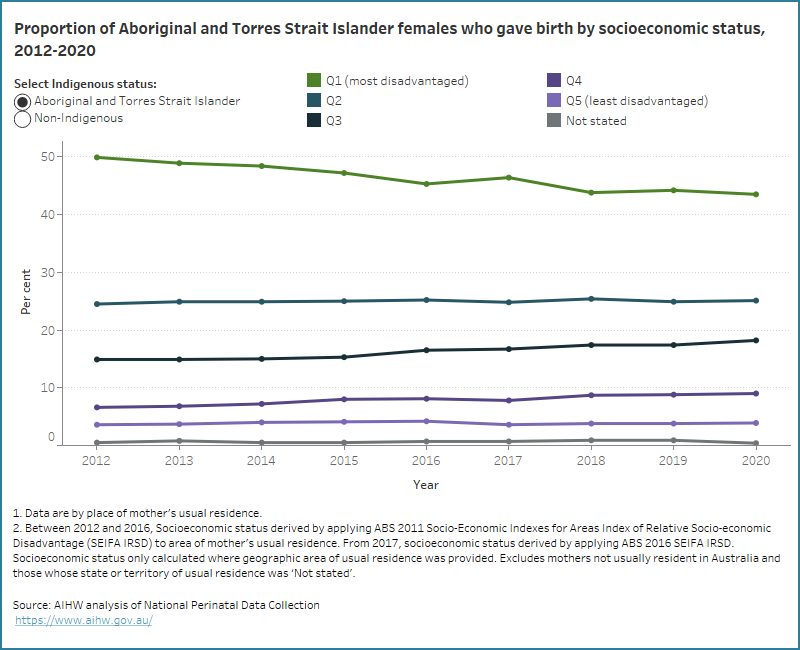 Socioeconomic status
Socioeconomic status
Socioeconomic status is a key social determinant of health, and the association between socioeconomic disadvantage and health can explain a substantial part of the health gap between Aboriginal and Torres Strait Islander people and non-Indigenous Australians (Arabena 2020; AIHW 2020).
However, focusing solely on the social determinants of health – and socioeconomic disadvantage – does not acknowledge the importance of the cultural determinants which are pivotal for Aboriginal and Torres Strait Islander peoples to achieve and maintain optimum health and wellbeing (Verbunt et al. 2021) (for more information see Cultural determinants of health).
Previous reports show that mothers who live in the most socioeconomically disadvantaged areas are more likely to be aged under 20, smoke during pregnancy, be obese, and give birth to pre-term or low birthweight babies than mothers who lived in the least disadvantaged areas (AIHW 2022).
Socioeconomic disadvantage in this report is based on the relative disadvantage of an area – calculated by looking at multiple factors such as income, level of education employment (for more information see Box 1 in the Introduction).
This report shows that Aboriginal and Torres Strait Islander females who gave birth and lived in the most disadvantaged areas were more likely than those in the least disadvantaged areas to:
- be aged under 20
- smoke during pregnancy
- be underweight or obese (a body mass index of 30 or more. For more information see Healthy maternal weight).
- have pre-existing diabetes and hypertension
- give birth to a baby who was pre-term, of low birthweight or small for gestational age.
In 2020, 44% of Aboriginal and Torres Strait Islander females who gave birth lived in the most disadvantaged areas and 3.9% lived in the least disadvantaged areas, which contrasts with non-Indigenous females (18% for both).
Over time, the proportion of Aboriginal and Torres Strait Islander females who gave birth and lived in the most disadvantaged areas has declined (from 50% in 2012 to 44% in 2020), whilst there has been a corresponding increase in those living in the third and fourth areas of disadvantage (from 15% in 2012 to 18% in 2020 for quintile 3 and from 6.6% in 2012 to 9.0% in 2020 for quintile 4). The proportion of Aboriginal and Torres Strait Islander mothers living in the least disadvantaged areas has remained largely unchanged (ranging between 3.6% in 2012 and 2017 and 4.2% in 2016).
The data visualisation below shows the proportion of Aboriginal and Torres Strait Islander and non-Indigenous females who gave birth by socioeconomic status of the area in which they lived, from 2012.
Figure 1: Proportion of Aboriginal and Torres Strait Islander and non-Indigenous females who gave birth by socioeconomic status from 2012 to 2020
Line graph of socioeconomic status by Indigenous status. Aboriginal and Torres Strait Islander mothers living in the most disadvantaged areas decreased

References
AIHW (Australian Institute of Health and Welfare) (2022) Australia’s mothers and babies, Cat. no. PER 101. Canberra: AIHW.
AIHW (2020) Aboriginal and Torres Strait Islander Health Performance Framework 2020 summary report. Cat. no. IHPF 2. Canberra: AIHW.
Arabena K (2020), ‘Country Can’t Hear English’: A guide supporting the implementation of cultural determinants of health and wellbeing with Aboriginal and Torres Strait Islander peoples, Melbourne: Karabena Publishing.
Verbunt E, Luke J, Paradies Y, Bamblett M, Salamone C, Jones A and Kelaher M (2021) ‘Cultural determinants of health for aboriginal and Torres Strait Islander people – a narrative overview of reviews’, International Journal for Equity in Health 20(181), doi: 10.1186/s12939-021-01514-2.


